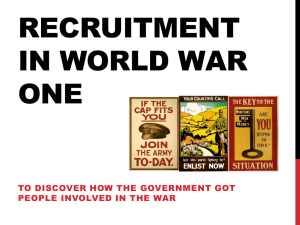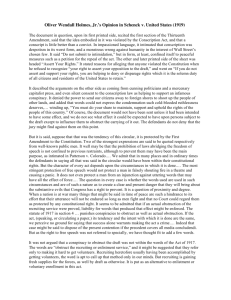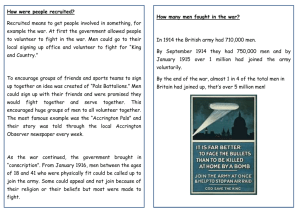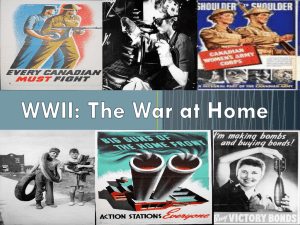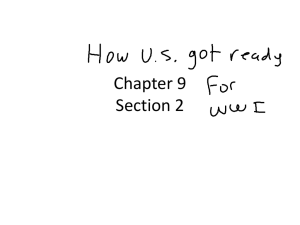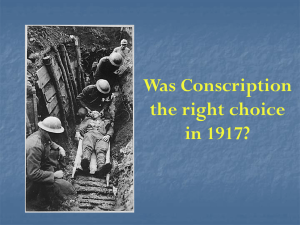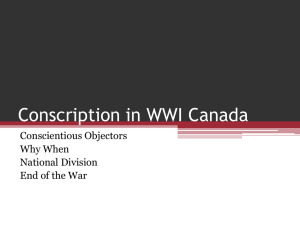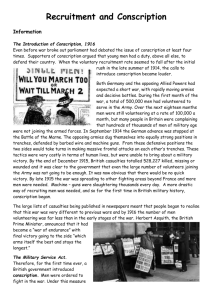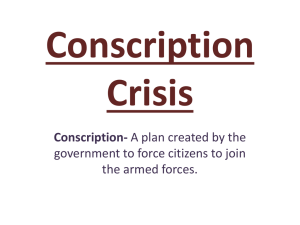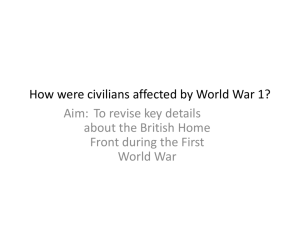QU 1 Recruitment PowerPoint
advertisement
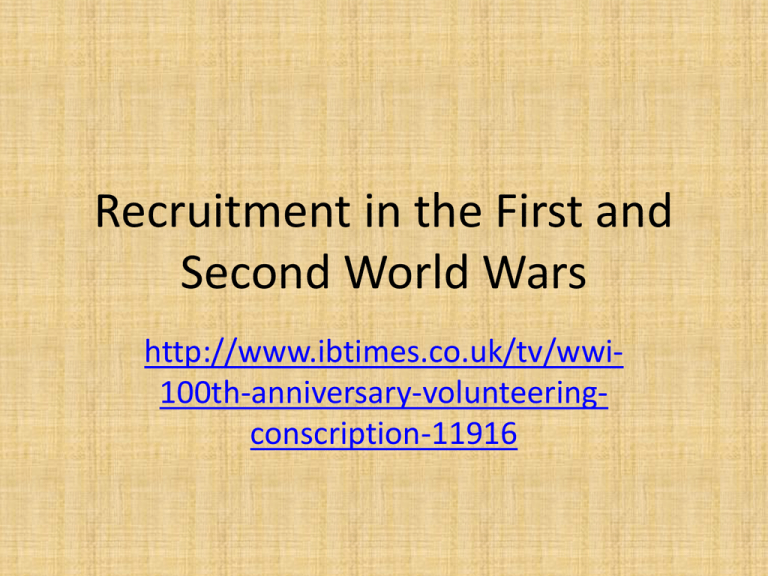
Recruitment in the First and Second World Wars http://www.ibtimes.co.uk/tv/wwi100th-anniversary-volunteeringconscription-11916 In the first World War as there was no conscription, posters were used to persuade men to enlist The Order of the White Feather Men were made to feel cowards for not joining up This white feather was sent to William Weller in Wolverhampton despite the fact that he was excused from the armed services on medical grounds and for doing vital war work. Men outside a recruiting office 1914 Conscription was introduced in 1916 Conscription in the Second World War • Men between the ages of 20 and 21 had been called up for 6 months training from April 1939 • On Sept 3rd the day war broke out the National Service Act introduced conscription for all men aged 19-41. men aged 20 – 23 were the first to be called up • http://www.britishpathe.com/video/fornational-safety-and-british-freedom-conscripti Men in Recruiting Stations First World War Second World War Conscientious Objectors in the First World War ‘Conchies’ were ridiculed Postcard 1916 Conscientious Objectors in the Second World War at Dyce Work Camp Aberdeenshire Local Defence Volunteers at Hatfield 1940 https://www.youtube.com/watch?v=0V3SqxU omwk Those too old, too young or not physically fit to be enlisted joined the LDV or Home Guard. It was soon known as ‘Dad’s Army’ Some people poked fun at the Home Guard Clips from ‘Dad’s Army’ • https://www.youtube.com/watch?v=0V3SqxU omwk • https://www.youtube.com/watch?v=b_Uw5eY xV4U The Role of Women in Both World Wars • In the First World War all women who worked for the war effort were volunteers. • In the Second World War women were conscripted in Dec 1941 https://www.youtube.com/watch?v=4QgKDfBW SuY (the film was made before conscription was introduced) First World War Munitions workers Land Army Voluntary Aid Detachment (Nursing) Second World War Conscription of Women From spring 1941 every woman in Britain aged 18-60 had to register with the Government. In December 1941 the National Service Act was passed this made the conscription of women legal. Single women, aged 20-30, were called up first. By 1943, 90% of single women and 80% of married women were employed in jobs related to the war. The Women’s Auxiliary Air Force (WAAF) was created in 1939. The main reason was to release men to fight on the front line. The women of the WAAF carried out almost all the men’s jobs except flying in combat. Members of the WAAF – Flight Mechanics These women were responsible for things like aircraft maintenance and controlling barrage balloons. Propaganda Posters of the Second World War The Women’s Royal Naval Service, like the WLA, was first formed during the First World War. In April 1939 the WRNS, or Wrens, was reformed. Like with the WAAF the WRNS main purpose was to free up men to fight the war. The women who joined were usually from families living near the ports. Between December 1939 and June 1945 the number of Wrens rose from 3,400 to 72,000. Members of the Women’s Land Army Wrens rolling out a torpedo from a submarine in 1943. Women making barrage balloons in Manchester. During the First World War the British Government established the Women’s Land Army. This army of women workers was reformed in 1938. Women who joined were usually from towns and cities. The women were noticed for their outfit of green jerseys (jumpers), brown breeches (trousers) and brown hats. The women did a variety of jobs from milking and general farm work to cutting down trees and catching rats. By 1944 80,000 women worked on the land. The WLA lasted until 1950. Princess Elizabeth (The Queen) aged 19 in the ATS, 1945 Exam Board Source: A • Reginald Haine, who joined the Honourable Artillery Company, recalls enlisting in the First World War. • The extract comes from Forgotten Voices of the Great War. It was edited by Max Arthur for Ebury Press in association with the Imperial War Museum and published in 2002. Source A Exam Board Source: B • A poster published by the Parliamentary Recruiting Committee in 1915. August and September 1914 – a surge in recruiting After a relatively slow start, there was a sudden surge in recruiting in late August and early September 1914. In all, 478,893 men joined the army between 4 August and 12 September, including 33,204 on 3 September alone – the highest daily total of the war and more than the average annual intake in the years immediately before 1914. Apart from a bedrock of patriotism and a widespread collective sense of duty to King and Empire, two factors, in particular, helped to generate this boom in enlistment. One was the formation on 31 August of the Parliamentary Recruiting Committee (PRC), which placed at the disposal of the War Office the entire network of local party political organisations. The assistance which the PRC provided included the issue of a series of memorable recruiting posters designed by leading graphic artists of the day. Another key factor in stimulating enlistment was the granting of permission to committees of municipal officials, industrialists and other dignitaries, especially in northern England, to organise locallyraised ‘Pals’ battalions, which men from the same community or workplace were encouraged to join on the understanding that they would train and, eventually, fight together. Many other men, however, enlisted for adventure or to escape from an arduous, dangerous or humdrum job. Source B: • Britain’s army at the beginning of the First World War was relatively small and professional. There was no conscription of population before 1916, and so recruitment of volunteers in large numbers became a huge challenge. The Parliamentary Recruitment Committee was set up at the start of the War, and chaired by the Prime Minister, Herbert Asquith. It used local political party associations to form a network which campaigned through the circulation of leaflets and posters, and organising rallies and other public events. Considerable social pressure was brought to bear on men to volunteer, and those who did not risked vilification as ‘shirkers’ or cowards. For many men, however, awareness of their responsibilities towards their families as wage earners proved a compelling disincentive to volunteer. Often, the levels of compensation offered to the families of men who enlisted were not sufficient to avert the risk of destitution to wives and children or elderly parents. Posters like this used that powerful sense of duty to family, but instead suggested that, in the future, children would hold their fathers to account on the service that they performed for their country rather than the social protection that they ensured for their immediate family. This poster shows a sophisticated use of art and imagery in provoking a powerful emotional response. These visually strong examples are among the best remembered, and more commonly reproduced, war posters. However, British recruitment posters were often much simpler in design, using only text and single colours. Exam Board Source: C • A poster published in 1940 by the Royal Air Force in the Second World War. Source C: Exam Board Source: D • Albert Rowland recalls his time as a conscientious objector in the Second World War. • From his contribution to the BBC’s People’s War website, provided in 2005. Source D:
